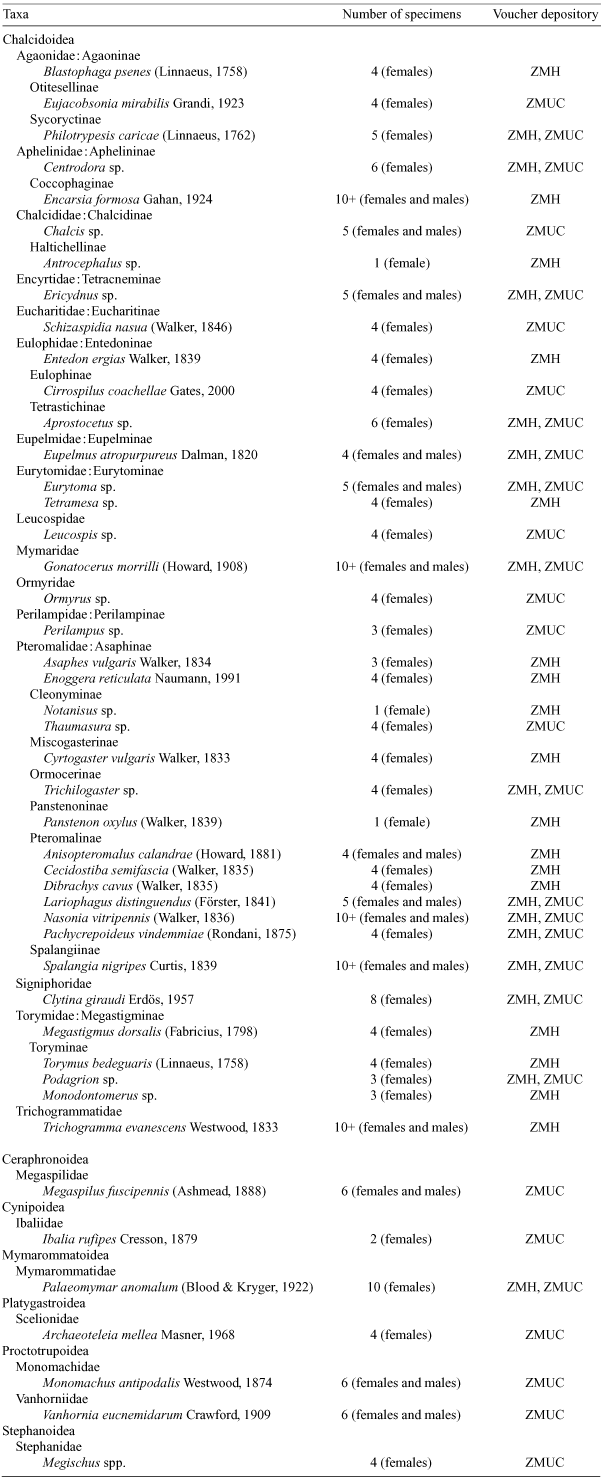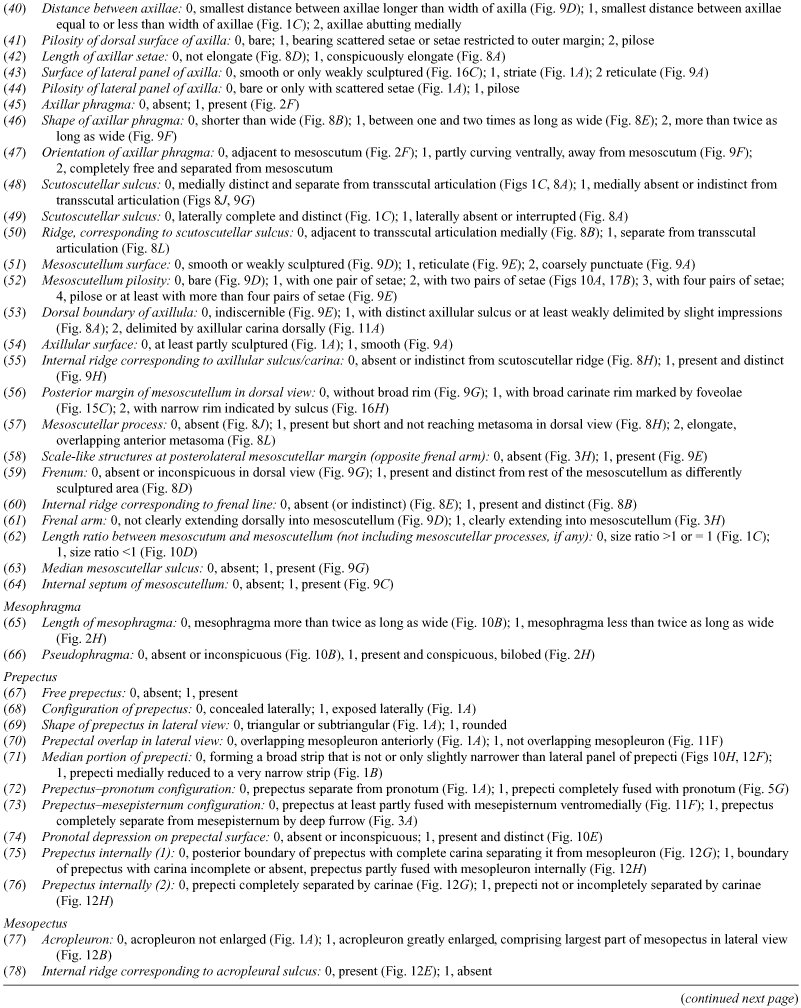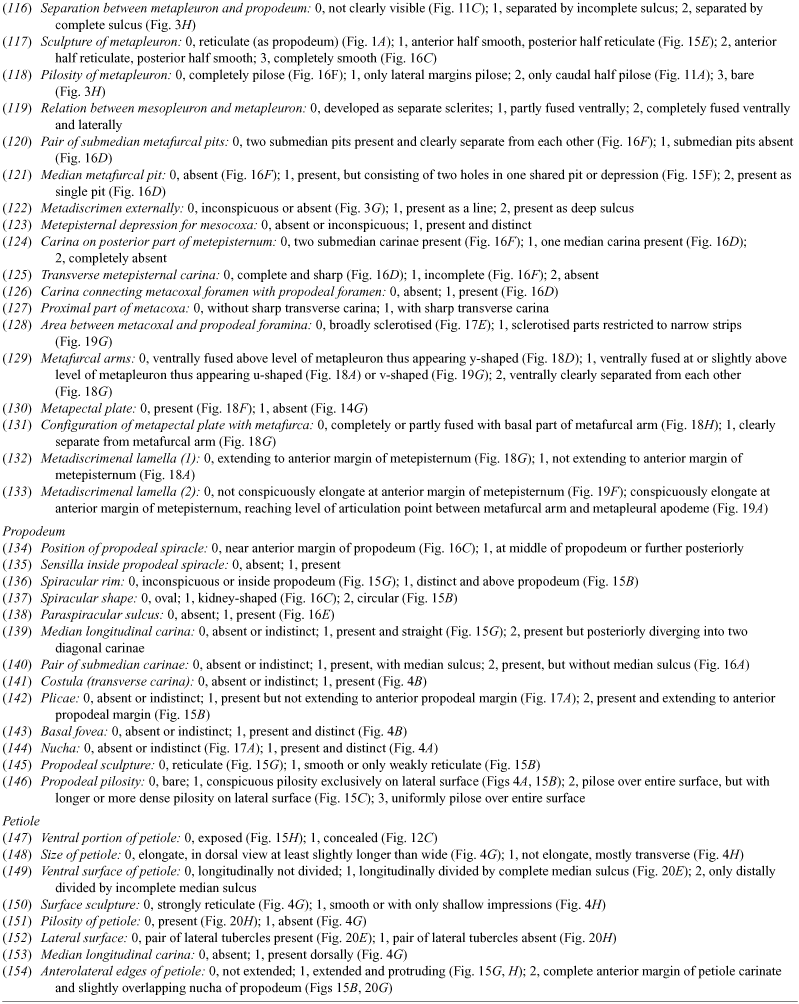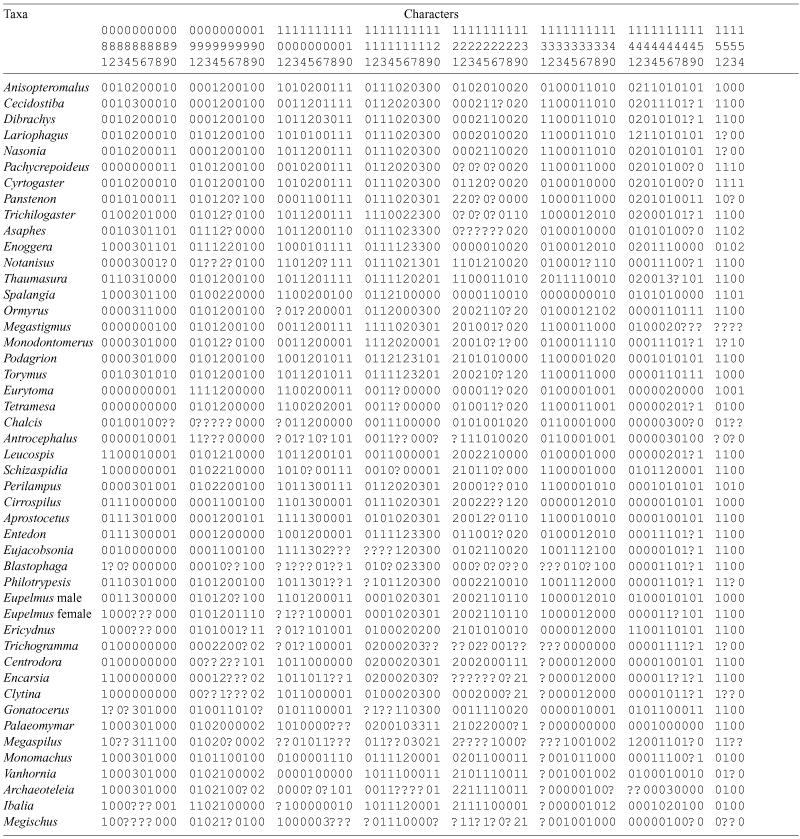Phylogenetic implications of the mesosomal skeleton in Chalcidoidea (Hymenoptera, Apocrita) – tree searches in a jungle of homoplasy
Lars Krogmann A C and Lars Vilhelmsen BA Zoological Institute and Zoological Museum, University of Hamburg, Martin-Luther-King-Platz 3, D-20146 Hamburg, Germany.
B Zoological Museum, Natural History Museum of Denmark, University of Copenhagen, Universitetsparken 15, DK-2100 Copenhagen, Denmark.
C Corresponding author. Email: lak@gmx.net
Invertebrate Systematics 20(6) 615-674 https://doi.org/10.1071/IS06012
Submitted: 14 April 2006 Accepted: 14 September 2006 Published: 15 December 2006
Abstract
Results from a comparative anatomical study of the mesosomal skeleton of Chalcidoidea are presented. External and internal features are described and illustrated for 39 chalcidoid taxa, representing 16 families and 29 subfamilies. This is the most comprehensive morphological study ever conducted for the superfamily. The mesosoma was dissected, macerated and investigated using scanning electron microscopy. The mesothorax and metathorax contributed most of the phylogenetically relevant information. The metafurca is highly variable within Chalcidoidea but seems to be relatively constant at the subfamily level. One hundred and fifty-four morphological characters were scored and analysed cladistically. Outgroup species were chosen from six apocritan superfamilies: Stephanoidea, Ceraphronoidea, Cynipoidea, Platygastroidea, Proctotrupoidea and Mymarommatoidea. Some previously suggested chalcidoid relationships were retrieved: (1) Pteromalidae: Pteromalinae + Miscogasterinae + Panstenoninae; (2) Perilampidae + Eucharitidae; (3) Chalcididae + Leucospidae + Eurytomidae; (4) Eulophidae: Eulophinae + Tetrastichinae + Entedoninae; and (5) Eupelmidae + Encyrtidae. Mymarommatoidea renders Chalcidoidea paraphyletic in our analyses; however, the taxon sample is too restricted to provide a robust hypothesis. Three previously unreported putative autapomorphies of Chalcidoidea were revealed: (1) presence of an exposed, triangular or diamond-shaped prosternum; (2) presence of a percurrent mesopleural sulcus anteriorly terminating in the acropleuron; and (3) presence of paired metapectal plates lateral to the metafurca.
Additional keywords: character evolution, cladistic analysis, comparative anatomy, phylogenetic systematics.
Acknowledgments
This study arose from the first author’s PhD thesis, which was conducted in the Zoological Museum Hamburg and supported by a fellowship from the University of Hamburg. The first author is greatly indebted to his supervisor Rudolf Abraham for advice and encouragement throughought the project and for numerous discussions on pteromalid and chalcidoid phylogeny. Renate Walter (ZMH) kindly assisted with preparing many of the SEM pictures. The staff from the Entomological Department of the Zoological Museum, Copenhagen is acknowledged for extensive help and for maintaining a great working atmosphere during two visits made by the first author. These visits were financed by the German Academic Exchange Service (April–July 2004) and the SYNTHESYS project of the European Union (May–August 2005). The second author acknowledges the Danish Natural Science Council for general support. Gary Gibson (CNC, Ottawa) thoroughly revised an earlier version of this manuscript and made substantial comments that greatly improved the paper. Special thanks are also due to John Heraty and Johan Liljeblad (University of California, Riverside) for organising the ‘Chalcid workshop’ (September 2005) on morphological character systems which provided essential information on character scoring and coding in Chalcidoidea. The following individuals donated specimens for our study or helped with the identification: Kathleen Campbell (University of California, Riverside, USA), Gérard Delvare (CIRAD, Montpellier, France), John Huber (CNC, Ottawa, Canada), Fiona Impson (ARC-Plant Protection Research Institute, South Australia), Michael Ohl (Museum für Naturkunde, Humboldt University Berlin, Germany), Ralph Peters (University of Hamburg, Germany), Matthias Schöller (Biological Consultancy, Berlin, Germany), Kai Schütte (University of Hamburg, Germany), Johannes Steidle (Institute for Zoology, University of Hohenheim, Germany), and Marc Török (Hamburg, Germany).
Bouček Z.
(1963) A taxonomic study in Spalangia Latr. (Hymenoptera, Chalcidoidea). Acta Entomologica Musei Nationalis Pragae 35, 429–512.
[verified 8 August 2006.]
Quicke D. L. J.,
Fitton M. G.,
Tunstead J. R.,
Ingram S. N., Gaitens P. V.
(1994) Ovipositor structure and relationships within the Hymenoptera, with special reference to the Ichneumonoidea. Journal of Natural History 28, 635–682.
| Crossref | GoogleScholarGoogle Scholar |

Rasnitsyn A. P.
(1980) Origin and evolution of Hymenoptera. Trudy Paleontologicheskogo Instituta [In Russian.] 174, 1–192 .

Rasnitsyn A. P.,
Basibuyuk H. H., Quicke D. L. J.
(2004) A basal chalcidoid (Insecta: Hymenoptera) from the earliest Cretaceous or latest Jurassic of Mongolia. Insect Systematics & Evolution 35, 1–13.

Rasplus J.-Y.,
Kerdelhué C.,
Le Clainche I., Mondor G.
(1998) Molecular phylogeny of fig wasps. Agaonidae are not monophyletic. Comptes Rendus de l'Académie des Sciences. Series III. Sciences de la Vie 321, 517–527.
| Crossref | GoogleScholarGoogle Scholar |

Ronquist F., Nordlander G.
(1989) Skeletal morphology of an archaic cynipoid, Ibalia rufipes. Entomologica Scandinavica. Supplementum 33, 1–60.

Ronquist F.,
Rasnitsyn A. P.,
Roy A.,
Eriksson K., Lindgren M.
(1999) Phylogeny of the Hymenoptera: a cladistic reanalysis of Rasnitsyn’s (1988) data. Zoologica Scripta 28, 13–50.
| Crossref | GoogleScholarGoogle Scholar |

Sharkey M. J., Roy A.
(2002) Phylogeny of the Hymenoptera: a reanalysis of the Ronquist et al. (1999) reanalysis, emphazising wing venation and apocritan relationships. Zoologica Scripta 31, 57–66.
| Crossref | GoogleScholarGoogle Scholar |

Shcherbakov D. E.
(1981) Morphology of the pterothoracic pleura in Hymenoptera. 2. Modifications of the ground plan. Zooligicheskii Zhurnal [In Russian, translation by multilingual services division, Secretary of State, Canada.] 60, 205–213..

Snodgrass R. E.
(1942) The skeleto-muscular mechanisms of the honey bee. Smithsonian Miscellaneous Collections 103, 1–120.

Van den Assem J.
(1974) Male courtship patterns and female receptivity signal of Pteromalinae (Hym., Pteromalidae), with a consideration of some evolutionary trends and a comment on the taxonomic position of Pachycrepoideus vindemiae. Netherlands Journal of Zoology 24, 253–278.

Viggiani G., Battaglia D.
(1984) Male genitalia in the Aphelinidae (Hymenoptera: Chalcidoidea). Researches on Hymenoptera Chalcidoidea. LXXXV. Bolletino del Laboratorio di Entomologia Agraria 'Filippo Silvestri' di Portici 41, 149–171.

Vilhelmsen L.
(2000a) Cervical and prothoracic skeleto-musculature in the basal Hymenoptera (Insecta): Comparative anatomy and phylogenetic implications. Zoologischer Anzeiger 239, 105–138.

Vilhelmsen L.
(2000b) Before the wasp-waist: comparative anatomy and phylogenetic implications of the skeleto-musculature of the thoraco-abdominal boundary region in basal Hymenoptera (Insecta). Zoomorphology 119, 185–221.
| Crossref | GoogleScholarGoogle Scholar |

Vilhelmsen L., Krogmann L.
(2006) Skeletal anatomy of the mesosoma of Palaeomymar anomalum (Blood & Kryger, 1922) (Hymenoptera: Mymarommatidae). Journal of Hymenoptera Research 15, 290-306.

Walker F.
(1833) Monographia Chalciditum. Entomological Magazine 1, 367–384.

Weber H.
(1926) Der Thorax der Hornisse. Ein Beitrag zur vergleichenden Morphologie des Insektenthorax. Zoologische Jahrbücher. Abteilung für Anatomie und Ontogenie der Tiere 47, 1–100.

Whitfield J. B.,
Johnson N. F., Hamerski M. R.
(1989) Identity and phylogenetic significance of the mesopostnotum on nonaculeate Hymenoptera. Annals of the Entomological Society of America 82, 663–673.

Wijesekara G. A. W.
(1997) Phylogeny of Chalcididae (Insecta: Hymenoptera) and its congruence with contemporary hierarchical classification. Contributions of the American Entomological Institute 29, 1–61.

Woolley J. B.
(1988) Phylogeny and classification of the Signiphoridae (Hymenoptera: Chalcidoidea). Systematic Entomology 13, 465–501.


|

|

|

|

|

|

|


